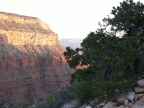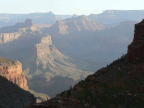Wednesday, April 30, 2008
Grand Canyon: Hiking down
The day before the hike, the group met for the first time, mainly for briefing and to distribute the "commissary", or shared load. The commissary consisted of pillow cases containing about 10 pounds each of food, kitchen tools, cooking fuel, and so on. Each person in the group carried one, which, fortunately for us, got lighter as the trek progressed.
The morning of the beginning of our trek, we met at the (to me) ungodly hour of 4:45, to catch a 5:00 shuttle bus to our trailhead. The westernmost point accessible from the South Rim Grand Canyon Village is a place called Hermit's Rest, and this is where we began our trek. The pictures at left are a basically chronological sequence of the descent into the canyon.
The widely-seen parts of the Grand Canyon have a somewhat straightforward structure. The Colorado River is cutting a gorge down the middle of the canyon, through an extremely hard layer of volcanic schist. About 1000 feet above this is a relatively broad area where sedimentary layers predominate. This occurs because the sediments erode by wind, water, and flash flooding faster than the schist layer. It is at this layer that the Tonto trail roughly parallels the canyon. Most treks through the canyon consist of a hike down from the rim to the Tonto, traversing along the Tonto, and then returning to the rim, likely in a different place. There may be trips down to the river along one of the side canyons.
In this trip, we descended the Hermit Trail to the Tonto, and then traversed west for 6 days. (For those paying close attention, this means we traveled away from the widely-seen portions of the canyon that are visible from the south rim.) On two occasions we descended to the river, once to camp, and once (on the last day in the canyon) to have a "day off".
Subscribe to:
Post Comments (Atom)















No comments:
Post a Comment